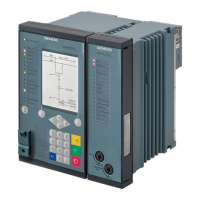Information List
No. Information Data Class
(Type)
Type
User curve #
_:81 User curve #:>Block stage SPS I
_:84 User curve #:>Activ. dyn. settings SPS I
_:500 User curve #:>Block delay & op. SPS I
_:54 User curve #:Inactive SPS O
_:52 User curve #:Behavior ENS O
_:53 User curve #:Health ENS O
_:60 User curve #:Inrush blocks operate ACT O
_:62 User curve #:Dyn.set. AR cycle1act. SPS O
_:63 User curve #:Dyn.set. AR cycle2act. SPS O
_:64 User curve #:Dyn.set. AR cycle3act. SPS O
_:65 User curve #:Dyn.set. ARcycl.>3act SPS O
_:66 User curve #:Dyn.set. CLP active SPS O
_:67 User curve #:Dyn.set. BI active SPS O
_:68 User curve #:Dyn. set. blks. pickup SPS O
_:59 User curve #:Disk emulation running SPS O
_:55 User curve #:Pickup ACD O
_:56 User curve #:Operate delay expired ACT O
_:57 User curve #:Operate ACT O
Blocking of the Tripping by Device-Internal Inrush-Current Detection
Description
With the Blk. w. inrush curr. detect. parameter, you can define whether tripping of the stage
should be blocked when a threshold value is exceeded due to an inrush current. In case of a blocking, the
stage picks up. The start of the tripping delay and the trip signal are blocked. The function signals this through
a corresponding indication. If the blocking drops out and the threshold value of the stage is still exceeded, the
time delay is started. After that time, the stage operates. The following figure only shows the part of the stage
(exemplified by definite-time overcurrent protection stage 1) that illustrates the influence of the blocking.
Only if the central function Inrush-current detection (see chapter 11.12 Inrush-Current Detection) is in effect
can the blocking be set.
7.4.6.4
7.4.7
7.4.7.1
Protection and Automation Functions
7.4 Overcurrent Protection, Phases
628 SIPROTEC 5, High-Voltage Bay Controller, Manual
C53000-G5040-C015-9, Edition 11.2017

